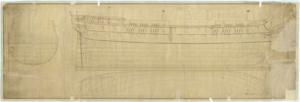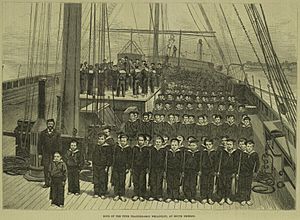HMS Cornwall (1812) facts for kids

Cornwall
|
|
Quick facts for kids History |
|
|---|---|
| Name | Cornwall |
| Namesake | Cornwall |
| Ordered | 13 July 1807 |
| Builder | Barnard, Deptford |
| Laid down | February 1808 |
| Launched | 16 January 1812 |
| Renamed | Wellesley, 18 June 1868 |
| Fate | Broken up, 1875 |
| General characteristics | |
| Class and type | Vengeur-class ship of the line |
| Tons burthen | 1,751 25⁄94 bm |
| Length | 176 ft (54 m) (gundeck) |
| Beam | 47 ft 6 in (14.48 m) |
| Draught | 17 feet 10 inches (5.4 m) at deep load |
| Depth of hold | 21 ft (6.4 m) |
| Sail plan | Full-rigged ship |
| Armament |
|
HMS Cornwall was a large sailing warship built for the Royal Navy in the early 1800s. She was known as a 74-gun third-rate ship, meaning she carried 74 cannons. For most of her time, she was kept in reserve, ready to be used if needed. Later in her life, she became a special ship used as a reformatory and a school ship for young people. Cornwall was eventually taken apart in 1875.
Contents
About HMS Cornwall
Ship's Design and Features
Cornwall was a large ship, measuring about 53.6 meters (176 feet) long on her main gun deck. Her beam, or width, was about 14.5 meters (47 feet, 8 inches). The ship's draught, which is how deep she sat in the water, was about 5.4 meters (17 feet, 10 inches). Her hold depth was around 6.4 meters (21 feet).
The ship's size was measured at 1,751 tons using an old system called Builder's Old Measurement. Cornwall was armed with 74 guns. On her lower gundeck, she had twenty-eight 32-pounder cannons. The upper deck carried twenty-eight 18-pounder cannons.
On the quarterdeck, there were four 12-pounder guns and ten 32-pounder carronades. Carronades were shorter, lighter cannons used for close-range fighting. The forecastle (the front part of the ship) had two 12-pounder guns and two 32-pounder carronades.
After the Napoleonic Wars ended in 1815, some of her guns were changed. Two lower-deck guns were replaced with larger 68-pounder carronades. Also, two upper-deck guns were swapped for 18-pounder carronades. The ship usually had a crew of 590 officers and sailors.
Changes to Armament and Crew
In 1830, Cornwall was changed into a 50-gun fourth rate ship. This process, called razeeing, meant parts of her upper structure were removed. Her new armament included twenty-eight 32-pounders on the lower gundeck. She also had sixteen lighter 32-pounders on the upper deck. Four more 32-pounders were placed on the forecastle. Because of these changes, her crew size was reduced to 450 men.
Building and Service History
Cornwall was the third ship in the Royal Navy to be named after the county of Cornwall in England. The order for her construction was placed on May 30, 1809. She was built by Mrs. Frances Bernard at Deptford, a shipyard in London.
The ship's construction began in March 1809 when her keel was laid down. She was officially launched into the water on January 16, 1812. During the Napoleonic Wars, Cornwall served in the English Channel, helping to protect Britain's coasts.
Life as a School Ship
In 1859, Cornwall was loaned to an organization in London. They used her as a special school for young people who needed guidance, known as a juvenile reformatory school. This gave many young boys a chance to learn skills and get an education.
On June 18, 1868, Cornwall swapped names with another ship, Wellesley. The newly named Wellesley then moved to the River Tyne in northeast England. There, she continued her important role as a school ship, helping to train and educate more young people. The ship was finally taken apart, or broken up, at Sheerness in 1875.


